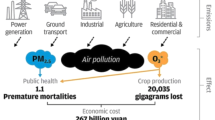Abstract
Tropospheric ozone concentrations, which are an important air pollutant, are modeled by the use of an artificial intelligence structure. Data obtained from air pollution measurement stations in the city of Istanbul are utilized in constituting the model. A supervised algorithm for the evaluation of ozone concentration using a genetically trained multi-level cellular neural network (ML-CNN) is introduced, developed, and applied to real data. A genetic algorithm is used in the optimization of CNN templates. The model results and the actual measurement results are compared and statistically evaluated. It is observed that seasonal changes in ozone concentrations are reflected effectively by the concentrations estimated by the multilevel-CNN model structure, with a correlation value of 0.57 ascertained between actual and model results. It is shown that the multilevel-CNN modeling technique is as satisfactory as other modeling techniques in associating the data in a complex medium in air pollution applications.
Similar content being viewed by others
References
Al-Ahmad, I. A., A. R. Azid, and K. N. Yusof, 2004: Emission control in palm oil mills using artificial neural network and genetic algorithm. Computers and Chemical Engineering, 28, 2709–2715.
Aleixandre, M., I. Sayago, M. C. Horrillo, M. J. Fernandez, L. Ares, M. Garcia, J. P. Santos, and J. Gutierrez, 2004: Analysis of neural networks and analysis of feature selection with genetic algorithm to discriminate among pollutant gas. Sensors and Actuators B: Chemical, 103, 122–128.
Bilgili, E., I. C. Goknar, A. M. Albora, and O. N. Ucan, 2005: Potential anomaly separation and archeological site localization using Genetically Trained Multi-Level Cellular Neural Networks. Electronics and Telecommunications Research Institute (ETRI) Journal, 27(3), 294–303.
Comrie, A. C., 1997: Comparing neural networks and regression model for ozone forecasting. Journal of the Air and Waste Management Association, 47, 653–663.
Chua, L. O., and L. Yang, 1988: Cellular neural networks: Application. IEEE Transactions on Circuits and Systems, 35(10), 1273–1290.
Danaci, E., 2002: Image processing with cellular neural networks. Ph. D. dissertation, Selcuk University Natural Science Institute, Konya, Turkey, 166pp.
Davis, L., 1991: Handbook of Genetic Algorithms. Van Nostrand Reinhold, New York, 385pp.
Elkamel, A., S. A. Wahab-Abdul, W. Bouhamra, and E. Alper, 2001: Measurement and prediction of ozone levels around a heavily industrialized area: A neural network approach. Advances in Environmental Research, 5, 47–59.
Gardner, M. W., and S. R. Dorling, 2000: Statistical surface ozone models: An improved methodology to account for nonlinear behavior. Atmos. Environ., 34, 21–34.
Holland, J. H. 1975: Adaptation in Neural and Artificial Systems. University of Michigan Press, Ann Arbor, MI, USA, 2nd ed., 228pp.
Kozek, T., T. Roska, and L. O. Chua, 1988: Genetic algorithms for CNN template learning. IEEE Transactions on Circuits and Systems, 40(6), 392–402.
Montastruc, L., C. Azzaro-Pantel, L. Pibouleau, and S. Domenech, 2004: Use of genetic algorithms and gradient based optimization techniques for calcium phosphate precipitation. Chemical Engineering and Processing, 43, 1289–1298.
Niska, H., T. Hiltunen, A. Karppinen, J. Ruuskanen, and M. Kolehmanien, 2004: Evolving the neural network model for forecasting air pollution time series. Engineering Applications of Artificial Intelligence, 17, 159–167.
Nunnari, G., S. Dorling, U. Schlink, G. Cawley, R. Foxall, and T. Chatterton, 2004: Modeling SO2 concentration at a point with statistical approaches. Environmental Modelling and Software, 19, 887–905.
Ozcan, H. K., U. Sahin, C. Bayat, and O. N. Ucan, 2005: ANN modeling of tropospheric ozone concentration of Istanbul City. Proc. HITEK 2005, High Technologies of Aviation Symposium, Turkish Air Force Academy, Istanbul, Turkey, 709–713.
Ozcan, H. K., O. N. Ucan, U. Sahin, M. Borat, and C. Bayat, 2006: Artificial neural network modeling of methane emissions at Istanbul Kemerburgaz-Odayeri Landfill Site. Journal of Scienfitic and Industrial Research, 65(2), 128–134.
Ruiz-Suarez, J. C., O. A. Mayora-Ibarra, J. Torres Jimenes, and L. G. Ruiz-Suarez, 1995: Short term ozone forecasting by artificial neural networks. Advances in Engineering Software, 23, 143–149.
Sahin, U., O. N. Ucan, B. Soyhan, and C. Bayat, 2004: Modeling of CO distribution in Istanbul using Artificial Neural Networks. Fresenius Environmental Bulletin, 13(9), 839–845.
Sahin, U., O. N. Ucan, C. Bayat, and N. Oztorun, 2005: Modeling of SO2 distribution in Istanbul using Artificial Neural Networks. Environmental Modeling and Assessment, 10, 135–142.
Sharma, S., A. K. Dikshit, and S. V. Barai, 2003: Studies on neural networks based air quality predictors. International Journal of Environment and Pollution, 19(5), 442–453.
Spellman, G., 1999: An application of artificial neural networks to the prediction of surface ozone concentrations in the United Kingdom. Applied Geography, 19, 123–136.
Tecer, L., 2000: Modeling of photochemical smog mechanism in Istanbul City. Ph. D. dissertation Cumhuriyet University Natural Science Institute, Sivas, Turkey, 135pp.
Wahab-Abdul, S. A., and S. M. Al-Alawi, 2002: Assessment and prediction of trophospheric ozone concentration levels using artificial neural networks. Environmental Modelling and Software, 17, 219–228.
Author information
Authors and Affiliations
Corresponding author
Rights and permissions
About this article
Cite this article
Ozcan, H.K., Bilgili, E., Sahin, U. et al. Modeling of trophospheric ozone concentrations using genetically trained multi-level cellular neural networks. Adv. Atmos. Sci. 24, 907–914 (2007). https://doi.org/10.1007/s00376-007-0907-y
Received:
Revised:
Issue Date:
DOI: https://doi.org/10.1007/s00376-007-0907-y




